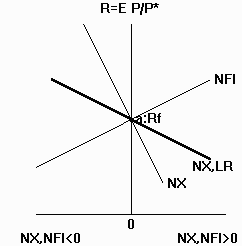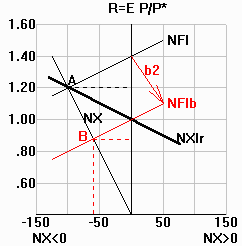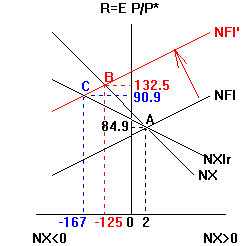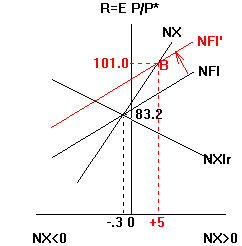| 6. |
(No diagrams are required to
receive full credit for this problem.) The following passages come from past
issues of the Los Angeles Times: |
|
a. |
"Strong
Dollar Bodes Well for U.S. Market," April
23, 2000: |
|
|
|
"The demand for dollar assets from around
the world has been phenomenal," says economist Stephen Roach of Morgan
Stanley....What's going on? In simplest terms, the rest of the world is making a living by
selling goods to the United States, which is paying them in dollars. But then, the nations
receiving those dollars are investing them back in U.S. government bonds and notes and in
the stocks and bonds of private companies. |
|
|
What is the impact of the activity described here
on each of the following for the U.S.: (1) net foreign investment (NFI), (2) real exchange
rate, and (3) current-account balance (net exports)? Discuss the reasoning behind your
answers.
(1) Savers shift to US =>
K-inflows => NFI falls (becomes more negative as US borrows
(2) R rises: as savers shift to US, demand for $ rises in FX
markets
(3) CAB falls: As R rises, US loses international
competitiveness => -X, +M. |
|
b. |
"Strong
Dollar Bodes Well for U.S. Market," April
23, 2000: |
|
|
|
[I]f ... the
Federal Reserve slam[s] the brakes on the U.S. economy, ... the resulting slowdown
would reduce imports and the international flow of investments. |
|
|
What sort of monetary policy is
this passage
describing? Do you agree that such a monetary policy would likely "reduce
imports and the
international flow of investments"? Why or why not?
This describes contractionary
MP.
Disagree: contractionary MP --> rdom
rises --> savers shift to US --> $ appreciation (+R) --> more imports and
more external borrowing, not less |
|
c. |
"Dollar Tumbles to New Multiyear
Lows," May 7, 2005: |
|
|
|
The weak dollar is slashing Americans'
purchasing power abroad. But it can help the economy.... |
|
|
Do you agree with the first
sentence? Why or why not? Do you agree with the second sentence? Why or why
not?
Agree: $ depreciation makes
foreign stuff more expensive to US when valued in $.
Agree: $ depreciation increases US international
competitiveness --> +NX, which can stimulate the economy and boost output. |
|
d. |
"Dollar Tumbles to New Multiyear
Lows," May 7, 2005: |
|
|
|
If the dollar's
weakness snowballs, it could cause foreigners to pull out of U.S. assets
rather than risk further devaluation of their holdings. That is already
happening on some scale. Foreigners pulled a net $418 million out of U.S.
stocks in the week ended May 2, according to UBS Warburg. That's the
fourth week in five that outflows rose. |
|
|
Do you think the drop in the value
of the dollar is better understood as the cause or the effect of the
"outflows" described in the passage? Explain briefly.
It's better understood as the
effect of K-outflows. NFI must shift to the right in order for the $ to
depreciate. So, savers must shift out of the US in order to make the $ fall.
Note: A cycle can then get started where the fall in
the $ can make savers worry that the $ will fall some more, making more
savers leave the US. However, the whole process has to start with a shift of
savers out of the country; otherwise the dollar won't fall in the first
place. |
| |
|
|
|



